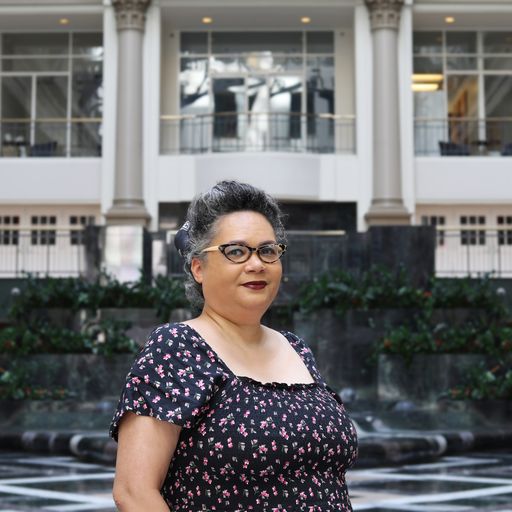In a world of marginalization and polarization, that’s all some people see.
During the times I spent at Creative Vision Factory over the last few months, I’ve met a business student, a construction worker, a photographer, an aspiring technologist and more than one social justice advocate.
On May 3, outside the last Wilmington Art Loop show ever at the Shipley Street site, Geraldo Gonzalez introduces himself, a camera around his neck and a large portfolio under his arm.
His reputation precedes him. Gonzalez is an artist and photographer who got his start at the Creative Vision Factory in the early ’10s, and went on to be awarded two grants from the Delaware Division of the Arts, with his work exhibited in Philadelphia, New York City and Melbourne, Australia. He’s no longer a regular member of CVF. He has his own studio and a job at ShopRite to pay the bills. He’s there to exhibit some of his art in support of the final show at Shipley.
At CVF, Gonzalez, also known as the “King of Transit” for his public transit-themed paintings and photographs, is something of a star. Not long after we met, he shared with me that he still doesn’t exactly fit in in some art circles.
“I do have people ask, ‘Are you a photographer?’” in an incredulous tone. He motions toward his gear. “I’m thinking, you didn’t notice that? Because if I say something back at them, they get offended real quick.”
The final Art Loop event is “everything must go,” said CVF staffer Joe Netta. In June, everything — the years of paintings, drawings, mosaics and ceramic sculptures that line every wall and shelf, every supply and piece of equipment — will be packed up to move to a new location, still unknown but somewhere in Wilmington.
Where are they moving? I’ll find them.Marquis Member at Creative Vision Factory
Just a few weeks before, CVF’s future was even more unknown, and the prospect of maintaining a peer-run, arts-focused, daytime drop-in for the behavioral health population in Wilmington appeared to be off the table. A contract with Impact Life, the mid-Atlantic-facing peer recovery and behavioral health nonprofit, was a life preserver with question marks all over it. Would CVF move to Impact Life’s Elsmere location? Or to a possible Impact Life site in Newark? If so, what about the people who relied on them in the city? Where will they go? How will they spend their days? How will they get the support services and personal connections they need to continue rebuilding their lives?
Then news came, just before the Art Loop, that Impact Life had closed on a location in the city that could give CVF a new home.
It took a huge load off of the small staff led by founder Michael Kalmbach, who himself is in long-term addiction recovery. As a peer-led organization, all the staff members have experience with at least one of the problems the members are going through. And that makes the question marks and uncertainty even more challenging.
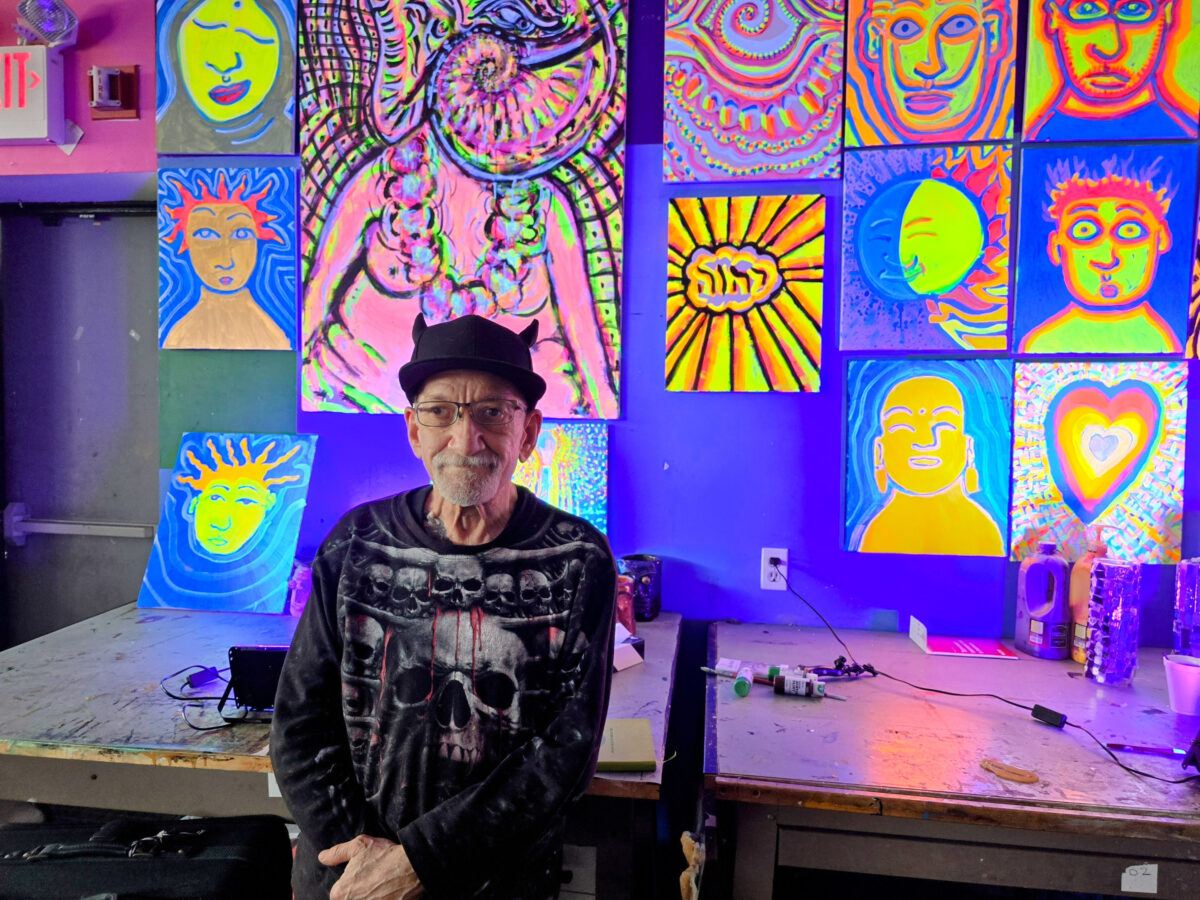
Part-time Creative Vision Factory staffer Ken Segal, a former computer programmer, has been on the team since 2011 (Holly Quinn/Technical.ly)
“This place closing down is like the death of a loved one,” said Ken Segal, a former computer programmer who has been on the CVF team since the beginning in 2011. He is now one of two part-time staffers. “It’s been a real part of my life, almost like a marriage or a relative. So when it closes, I’m going to go through a period of mourning, I’m sure. Already I’m kind of messed up. I have to watch it, because I have bipolar disease. I spent last Thursday in bed all day.”
Whether the part-timers, Segal and Netta, will have a place at the new Impact Life CVF is still up in the air.
“I guess I’ll go back to programming, but I have to go to school because my skills are out of date,” Segal said.
Chantal Matthews, the one CVF full-timer aside from Kalmbach, has no fallback. When she was recruited by Kalmbach in 2012, she was at home on disability with a service dog, and, she says, she couldn’t even cross the street because her illness was so severe.
“This is a workplace where I can have mental disabilities,” Matthews said. “I have bipolar, borderline personality disorder and PTSD, and short-term memory loss from an accident. So all of those things affect how I function.”
READ MORE: A refuge for troubled artists will leave Wilmington after decades
When she’s having a bad day at CVF, she says, she can feel safe in the knowledge that her colleagues are there for her, and she is comfortable sharing what she’s going through during the staff’s morning group sessions. Without that built-in support, she says, finding another job away from the place she now considers home feels nearly impossible.
The good news for Matthews is that her position was secured in the Impact Life contract. She’s happy that her employment will continue and she’ll follow Kalmbach to the next location. Still, it’s not easy.
“Change is hard,” she said.
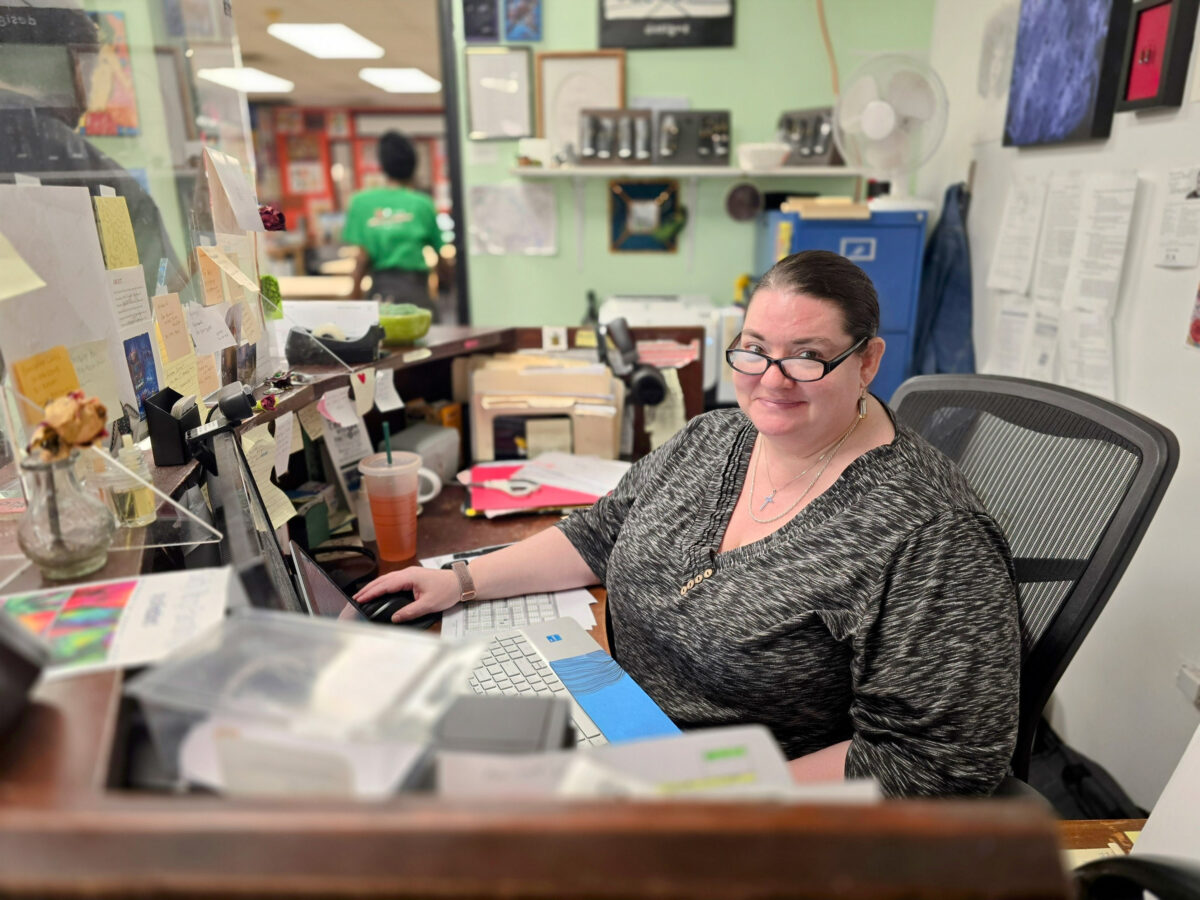
Chantal Matthews works full time at Creative Vision Factory after being recruited in 2012 (Holly Quinn/Technical.ly)
‘People express all kinds of emotions here’
Members don’t have to make art to come to CVF. In fact, Segal says, the majority don’t. It’s a safe place for people who may not have one otherwise.
“It’s safe enough that you’ll occasionally see someone fall asleep here,” he said. “At first we were a little annoyed, we would wake them up and say you can’t sleep here. But then we realized that they’re considering us a safe haven to put their head down. It’s actually a compliment.”
For the members who do make art, the act of creation can be transformational, even if it’s just a matter of having something to do. Kareem Crawford has a job in construction, but still comes to CVF on days when he doesn’t work.
“This is the place that I use to keep me out of trouble,” he says, noting he mostly paints and makes jewelry. “It’s relieving. It’s an outlet.”
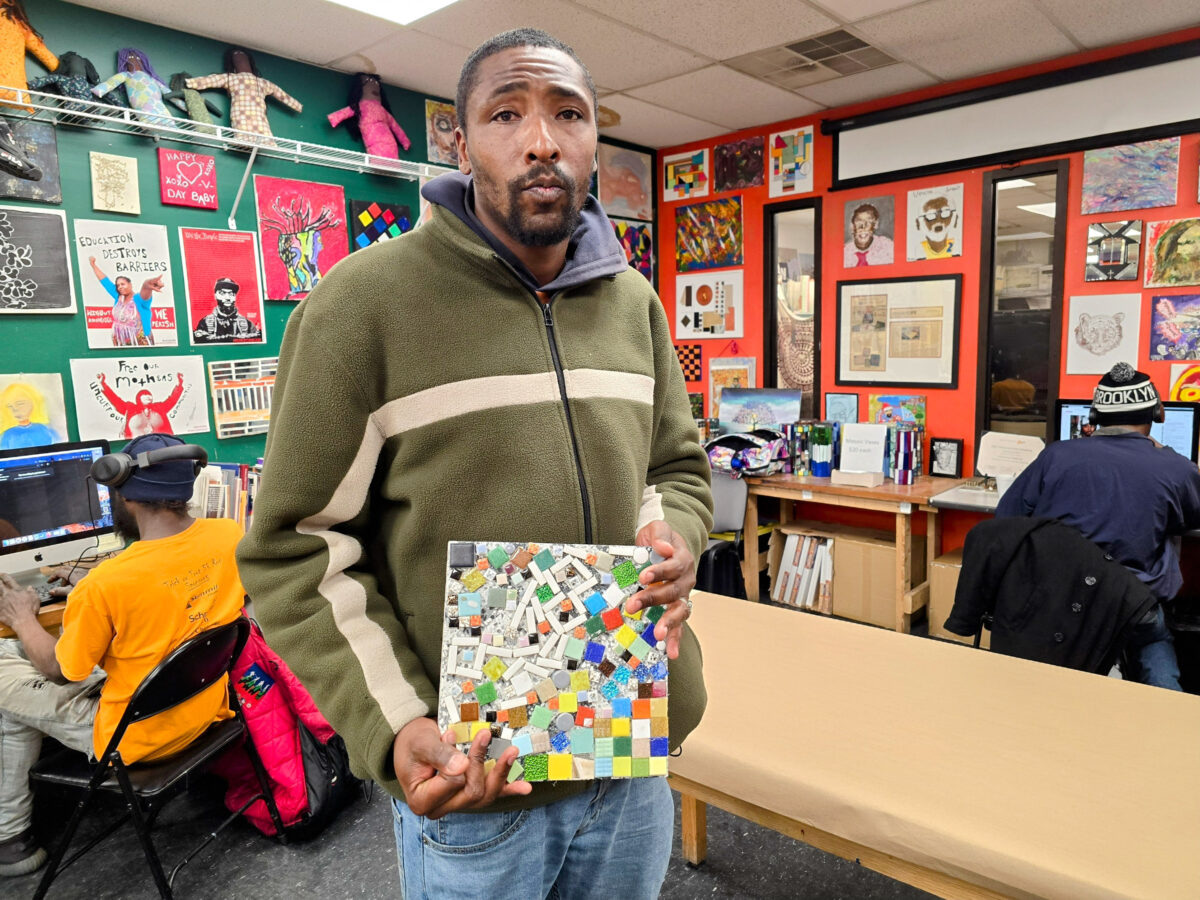
Kareem Crawford, who has a full time job in construction but spends his free time making artwork at Creative Vision Factory (Holly Quinn/Technical.ly)
A member named Marquis has a space in the back room near the kiln, surrounded by his art. He makes lots of small clay figures with voodoo doll-like faces, some with shocks of colorful yarn hair.
Tiarra crochets, a lot. At the show, she displays piles of neatly folded crochet scarves in different colors and patterns. Her grandmother taught her to knit, she says, and she learned crochet when she started coming to CVF.
Elisio makes fantastical ceramic figures shaped like animals, dinosaurs and angels. A display in the front room is set up to grab attention.
“You see, that says ‘decarceration,’” explains the artist, Davon Marque Hall. “It’s the opposite of mass incarceration.”
Hall knows more about mass incarceration than most. He served time in prison and now devotes his time to social justice advocacy. At the center of his display is a large clock repurposed into artwork with red and blue paint, with the words “DECARCERATE AMERICA” across it.

Clock by artist Davon Marque Hall, who was formerly incarcerated and now devotes his time to social justice advocacy (Holly Quinn/Technical.ly)
Hall is collecting signatures to run for Wilmington City Council, District 3, and shows passion for his causes, including environmental action. Recently, he says, he went through a local coding bootcamp.
“We have people that express all kinds of emotions here,” Segal said. “And all kinds of dreams. It is definitely cathartic.”
‘It’s time to start healing our community’
Meme (pronounced “me-me”) enters CVF with purpose as it reopens after its mid-day break one day in March. She’s pulling a shopping cart that’s filled to the top with stuff, which she starts to lay out on a table in front. There are bras, stuffed animals, and containers of food. She encourages members to take items before heading to a studio space she’s set up in the back room for her found object art.
Meme isn’t staff, but she envisions herself doing that work. She’s been coming to CVF since almost the very beginning, and, like other members, has gone through ups and downs with homelessness and addiction. Now she’s in a good place. She has a place to live and is working on earning a business degree, which she plans to follow immediately with a master’s degree.
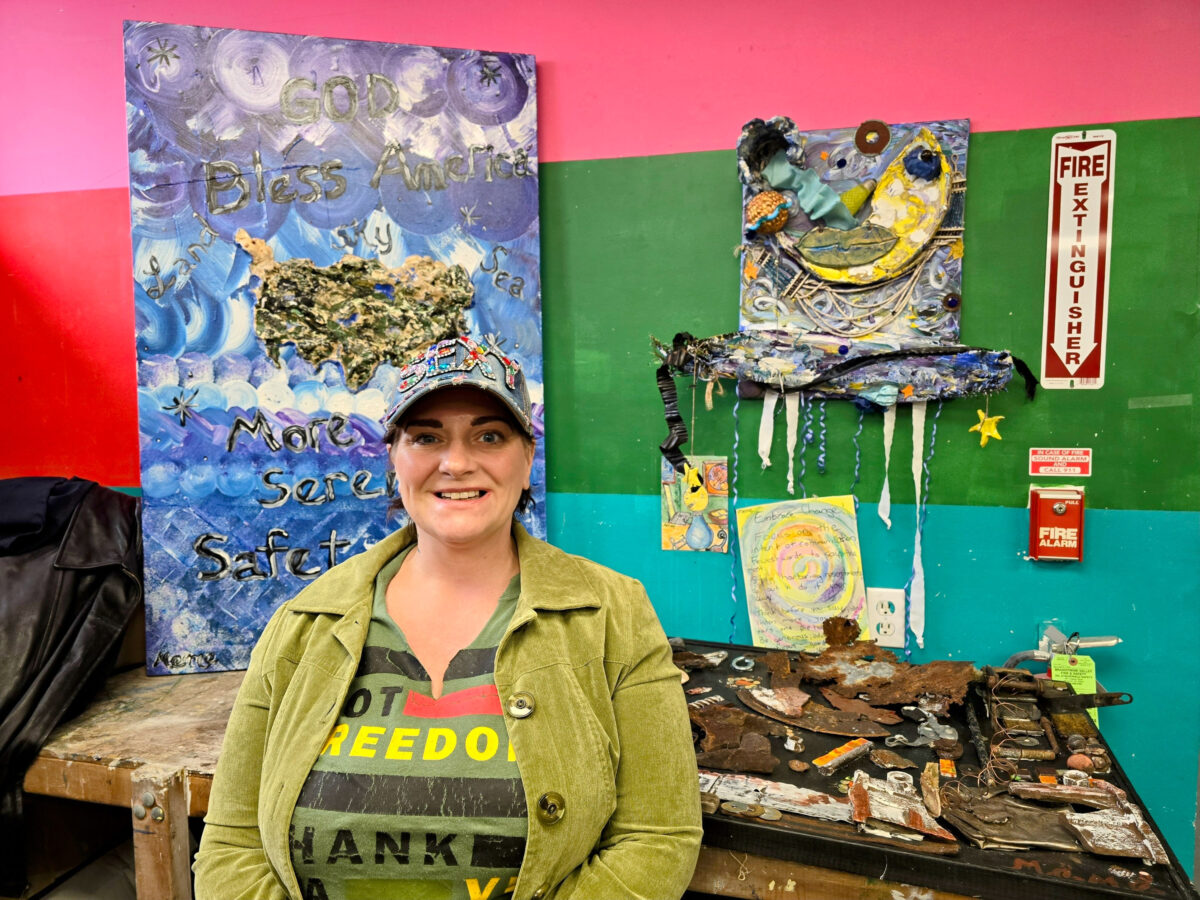
Creative Vision Factory member Meme dreams of running her own holistic learning and craft center for the community (Holly Quinn/Technical.ly)
Her goal? To run a completely holistic learning and craft center for this underserved community, including veterans and returning citizens. Her ideas, organized on sheets of paper, include cooking and nutrition lessons, yoga, deep breathing exercises, crochet and ceramics. She envisions a clothing pantry and place where people can lie down.
And she wants a reading room where people who are struggling can come and sit and read without judgment, with booths to put their shopping carts, if needed.
“I’m an inventor, and I’m trying to make better some of the things I dealt with being out in the street,” Meme said. “I’ve dealt with the whole drug thing and partying and all that. I don’t do that anymore. But the thing is, I know there’s people who [do] and it’s not right for them to be judged, or blamed, because they don’t know where that person came from. What that person went through, you know? It’s time to start healing our community.”
In the background, there is shouting coming from the front room, a scuffle that the staff quashes within a couple of minutes. Marquis shakes his head and goes back to making his clay figure. It’s a safe place, filled with people with hopes and dreams, but it’s still a place where the challenges that people see from the outside do exist. Sometimes, there are fights. Occasionally there is an overdose, a “Narcan reversal” as Kalmbach calls it, that brings police and emergency vehicles to Shiply Street, unnerving residents of the newer high-rise apartments nearby.
“Once after a Narcan reversal, we had a gentleman across the street step into a coffee that one of our guys left on the sidewalk,” Kalmbach said. “This man threatens everybody on the block and tells me to stop serving coffee to ‘the bums.’”
Matthews nods in recollection. “Or ‘we didn’t sign up for this social experiment,’” she said. “I was going out to lunch one day and I had a guy stop me. He was asking about the place, and he made that comment.”
At the end of the day, members of CVF are part of the community. At least for now, it’s going to stay that way, even if uncertainties remain about exactly where the program will be located in the city.
When I mention the move to Marquis, he sits up straight.
“Where are they moving?” Marquis asks. “I’ll find them.”
This article is the second in a series about the Creative Vision Factory by members of the Delaware Journalism Collaborative, a statewide partnership of local news organizations and community partners. Read the first story here. The DJC was formed in 2022 by the Local Journalism Initiative of Delaware to encourage the pooling of news gathering, reporting, editing and production efforts.
Before you go...
Please consider supporting Technical.ly to keep our independent journalism strong. Unlike most business-focused media outlets, we don’t have a paywall. Instead, we count on your personal and organizational support.
Join our growing Slack community
Join 5,000 tech professionals and entrepreneurs in our community Slack today!

The person charged in the UnitedHealthcare CEO shooting had a ton of tech connections

From rejection to innovation: How I built a tool to beat AI hiring algorithms at their own game

Where are the country’s most vibrant tech and startup communities?

